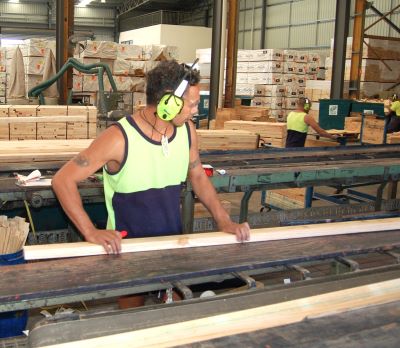Visual stress grading techniques

In this lesson we’re going to look in detail at the techniques used to visually stress grade softwoods and hardwoods. At the bottom of this page are various links that will take you to downloadable PDF documents, including grading cards and instructional sheets on how to measure and assess the main strength-reducing defects in timber.
The reason these documents are separated into softwoods and hardwoods is that the assessment methods are different, and for some growth characteristics even the terms used to identify them are different. But before you go on to study these documents, we should briefly describe basic principles of visual stress grading.
Looking at the piece
There are two main types of characteristics that you need to look for when you visually grade structural timber:
-
characteristics that have a strength-reducing effect on the piece, such as knots, resin or gum pockets, and sloping grain
-
characteristics that affect straightness, and therefore usability, such as bow, spring and twist.
The only way to be sure that you don’t miss anything important is to inspect all four sides and both end of every piece. If you’re working on a production line and need to grade pieces quickly, it’s best to have an offsider checking the far ends for you as the boards come down the line.
It’s not easy working quickly without sacrificing accuracy, but that’s part of the skill of being a good grader. Fortunately, you don’t need to study every defect in the piece – you only need to assess the worst characteristic, because that will be the one that determines the grade. So the trick is to roll the piece while you look up and down all surfaces, find the feature or combination of features that will give you the lowest grade, and then make your assessment.
If you’re reworking the pieces and cutting out bad defects, you’ll need to make an on-the-spot judgement as to whether it’s best to leave the piece long at a lower grade, or dock it to a shorter length (or lengths) and get a higher grade. You may also be re-sawing the width of the boards, in which case you’ll have to decide whether a large imperfection on a wide board is better than a smaller one on a narrower board. Obviously, if the defect you’re looking at is bad enough to reject the piece completely, then re-working it will be your only option.
Softwood grading
The links below will take you to various downloadable documents related to softwood visual stress grading. The first two provide information on how to identify, measure and assess the main characteristics that have an effect on the stress grade given to a softwood board.
The third document is a softwood ‘grading card’, based on AS 2858-2008. It is designed to be used a ready-reckoner by yard workers in a sawmill or timber yard, and can be printed out onto a double-sided A4 card and folded in half. Note that the grading rules are highly abbreviated and condensed, so you will need to read the ‘measurement and assessment’ documents in order to fully understand the abbreviations and technical terms.
Measurement and assessment of characteristics – softwoods *
Measurement and assessment of characteristics – seasoned radiata F5 and F7
* Provides a summary of the grade descriptions listed in Part 2 of AS 2858-2008, covering all softwood species other than cypress pine and hoop pine. Cypress and hoop have been given their own subsets of grading rules in the Australian Standard (in Parts 3 and 4 of AS 2858) since they tend to behave somewhat differently from the other softwoods due to their knot configurations and grain structure.
Hardwood grading
The documents linked below provide details on hardwood visual stress grading, based on AS 2082-2007. The first document provides information on how to identify, measure and assess the main strength-reducing characteristics that appear in hardwood boards.
The second document is a hardwood ‘grading card’. Like the softwood grading card, it can be printed out onto a double-sided A4 card and folded in half, for use as ready-reckoner in the yard. Again, you will need to read the ‘measurement and assessment’ document to make sense of the abbreviations and technical terms.